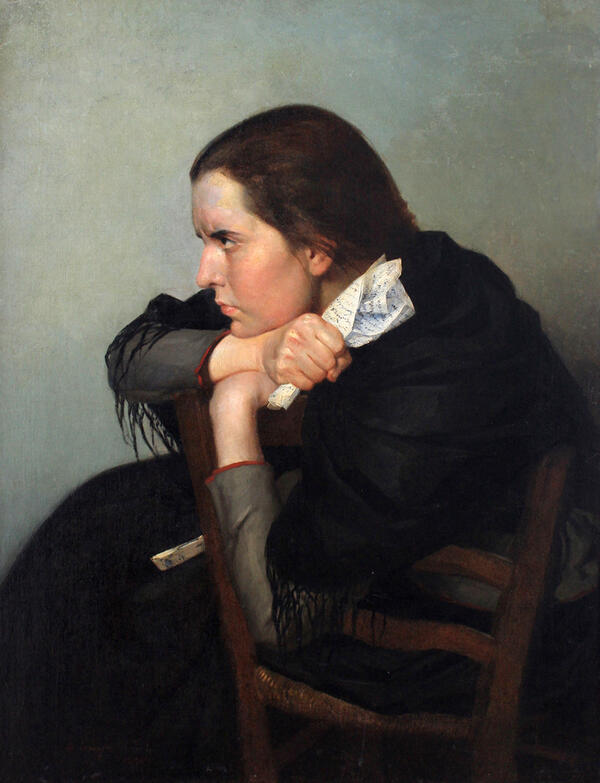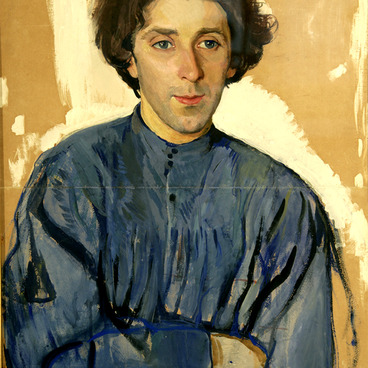Taganrog had not held a single art exhibition until 1887. The first exhibition, organized by the Itinerants (Peredvizhniki movement) in Taganrog, gave impetus to the development of artistic life at a completely new level. The next two exhibitions played a significant role in stimulating the local art community, including talented draftsman and painter Dmitri Sinodi-Popov (April 3, 1855, Taganrog - February 24, 1910, Paris). He belonged to a Greek merchant family that gave Taganrog several prominent figures, including S.G. Sinodi-Popov, director of the Taganrog Theater from 1844 to 1876.
Dmitri Sinodi-Popov was brought up at home, spoke three languages well (French, Italian and Greek), played the piano, but most of all was fond of painting. At the age of 17, he became an auditor at the Imperial Academy of Arts in Saint Petersburg, where he acquired good practical skills, but two years later he had to leave his studies due to health problems. In the late 1870s, the artist returned to Taganrog, where he continued to study and work independently.
Dmitri Sinodi-Popov’s creative heritage includes numerous drawings, sketches, and quick landscape studies. Among all his output, his portraits are particularly noteworthy. The most expressive of them is the genre portrait “The Letter”. It is known that 20-year-old Seraphima Blonskaya posed for this painting.
Seraphima Blonskaya was born on September 21, 1870 in Verkhnedneprovsk. Her father, Iason Blonsky, was a lawyer and her mother was the daughter of a medical professor. The Blonskys came to Taganrog when Seraphima turned five.
Blonskaya studied painting at the Imperial Academy of Arts in St. Petersburg. Her first success came with her graduate work called “Girls. Palm Sunday”, which is presented in the collection of the Taganrog Art Museum.
At a yearlong competitive exhibition at the Art Academy, the work of the young artist was awarded a gold medal and received excellent reviews in the press. It was immediately characterized as “a painting full of light, cheerful mood, freshness and true poetry.” After graduating from the Academy of Arts, Blonskaya was sent in Italy to improve her professional skills. In 1910, together with her husband, artist
Alexander Leontovski, Blonskaya returned to Taganrog and opened a private art school.
The painting depicts a young artist. In her hand, she squeezes the crumpled letter tightly and looks aside angrily. This is practically the only detail that indicates some kind of storyline outside the picture. The artist consciously focuses on the psychological state of the model. The gray and black color scheme emphasizes the mood.
Dmitri Sinodi-Popov was brought up at home, spoke three languages well (French, Italian and Greek), played the piano, but most of all was fond of painting. At the age of 17, he became an auditor at the Imperial Academy of Arts in Saint Petersburg, where he acquired good practical skills, but two years later he had to leave his studies due to health problems. In the late 1870s, the artist returned to Taganrog, where he continued to study and work independently.
Dmitri Sinodi-Popov’s creative heritage includes numerous drawings, sketches, and quick landscape studies. Among all his output, his portraits are particularly noteworthy. The most expressive of them is the genre portrait “The Letter”. It is known that 20-year-old Seraphima Blonskaya posed for this painting.
Seraphima Blonskaya was born on September 21, 1870 in Verkhnedneprovsk. Her father, Iason Blonsky, was a lawyer and her mother was the daughter of a medical professor. The Blonskys came to Taganrog when Seraphima turned five.
Blonskaya studied painting at the Imperial Academy of Arts in St. Petersburg. Her first success came with her graduate work called “Girls. Palm Sunday”, which is presented in the collection of the Taganrog Art Museum.
At a yearlong competitive exhibition at the Art Academy, the work of the young artist was awarded a gold medal and received excellent reviews in the press. It was immediately characterized as “a painting full of light, cheerful mood, freshness and true poetry.” After graduating from the Academy of Arts, Blonskaya was sent in Italy to improve her professional skills. In 1910, together with her husband, artist
Alexander Leontovski, Blonskaya returned to Taganrog and opened a private art school.
The painting depicts a young artist. In her hand, she squeezes the crumpled letter tightly and looks aside angrily. This is practically the only detail that indicates some kind of storyline outside the picture. The artist consciously focuses on the psychological state of the model. The gray and black color scheme emphasizes the mood.




